IARIGAI Dubrovnik – Cavtat
2003, Croatia – Advances in printing science and technology: proceedings
of the 30 th International iarigai Research Conference; UDK 655:004.91
> (063); 004.91:655 > (063); ISBN 953-96276-6-4 (tvrdi uvez);
ISBN 953-96276-7-2 (meki uvez), Acta Graphica Publishers
Mechanical and optical differences in long run printing
in conventional and CTP offset systems
Sanja Mahović , Darko Agić , Miroslav Gojo
University of Zagreb, Faculty of Graphic Arts
Croatia, 10000 Zagreb, Getaldićeva 2
E-mails: smahovic@grf.hr, mgojo@grf.hr
Abstract
In the recent years there has been a significant growth in the area
of platemaking. The development of electronic hardware and software,
data manipulation, image and platesetters, has resulted in systems that
image directly from computer to printing plates. From the commercial
point of view the usage of CTP technology is not in question. The elimination
of the film making phase and direct copying on printing plate has resulted
in saving materials, less operators handling, as well as in significantly
shorter graphic
workflow time. The aim of this article was to compare the mechanical
and optical properties in the conventional offset platemaking system
to CTP offset platemaking system. In both cases the same original
was reproduced in specified systems in optimal conditions. The focus
was on possible mechanical and optical differences on plates and prints
in the long run, which come as a result of different platemaking systems.
1. Background
The offer of CTP systems and back up material has diversified in the
last few years. Thermal and visible light technologies have overflowed
the world market. The workflow digitalization by installing the CTP
system demands adjustment and conversion of the whole work environment
in the printing house. Such changes represent new technical and organizational
challenges for the firms investing in
CTP technology. Nevertheless, the installation of CTP is viewed upon
with some skepticism due to high costs of the digitalization of the
production. Additionally there is a significant need for the
adjustment in the qualifications of the employees. A CTP operator
must be skilled with computers and he/she must be familiar with the
whole production process. In order for the new technology to be accepted
and adjusted to the new literature the ambition of the employees is
also required. The lack of information about the trends of technological
development leads to longer period of transformation
from conventional to digital surrounding. This lack of information
is the main reason why the conventional platemaking system still prevails.
Holding on to the conventional platemaking system
ensures the consistent quality of the reproduction. Nevertheless,
those graphic firms whose production must not be influenced and who
are forced to keep up with trends set up by the market are more likely
to make the decision to transfer to the CTP technology.
2. Introduction
There are lots of factors which influence the quality of the production.
Besides the working conditions in the prepress and printing department,
the significant role also plays the platemaking conditions.
In the conventional reproduction there is a greater possibility of
errors in the platemaking process, due to larger number of steps in
the process. The factors which influence the transfer of coverage
values
are the film and the printing plate quality, the type of photosensitive
layer, the exposure conditions, the contact between the film and printing
plate and the processing conditions (Richter, 1978). The mainreason
for the impossibility of the standardization of production is the
human factor. Human precision in the film assembly and imposition
directly influences the reproduction quality.
The possibility of error becomes much smaller with the elimination
of film making and with the introduction of electronic imposition.
The quality of printing plate and photosensitive layer, the source
of radiation used for exposure and the conditions of printing plate
developing can have influence on the occurring of errors (Seydel,
1996). The quality of the printing plate depends on the individual
phases of the platemaking as well as on the characteristics of CTP
system, the exposure time and the resolution (Adams, Romano, 1996).
The maintenance of the above mentioned parameters is to a
greater or smaller degree automatic.
The aim of this article is to explore the mechanical and the optical
differences of screen elements which are the outcome of the various
platemaking systems. Two procedures of the platemaking have
been observed. The first one is the conventional system and the other
one is the CTP system. In the CTP system there is much less deformation
of printing elements due to the elimination of the film
making phase. In the conventional system the copying and developing
cause the size deformations of the printing elements, which in effect
cause the change of the form of the characteristic reproduction curve.
In this article the mechanical and the optical differences of the
prints which are result of the different platemaking systems have
been observed. The changes of printing elements on the printing plates
which derive from the long run print as well as their influence on
the prints have been examined. The printing process has been led in
controlled conditions concerning ink and fountain
solution, and the printing substrate has not been changed.
3. Experimental
Computer generated the original and the control wedge with patches
from 10% to 100% of the surface coverage and ruling of 155 l/in have
been conventionally reproduced on printing plates and than
printed in offset. The same original has been reproduced by the computer
led CTP system directly onto the printing plates and has been printed
out in the same conditions.
The experimental part consists of film making for the conventional
procedure of the platemaking.
Through the copying and developing the information from the film has
been transferred to the printing plate, which will ensure the making
of the colored print on the paper in the further reproduction. The
printing plate for the conventional reproduction consists of aluminum
base with the light sensitive diazo layer. The photochemical reaction
in the layer is caused by the radiation of the metal halide lamp between
380 and 420 nm, with the power app. 5000W. The sensitivity of the
conventional printing plates is approx. 50 mJ/cm 2 (Diamond, 1991).
For this paper the CTP system with the internal geometry designed
platesetter and violet laser diodes (400 nm) with the power of 5 mW
has been used. Digital printing plates for this platesetter are silver
halide with the aluminum base sensitive on violet light and with the
technical capacity up to 350.000 prints depending on the press conditions.
The sensitivity of the silver halide printing plates is 0.01
mJ/cm 2 (Van hunsel, Van Damme, Vermeersch, Elsässer, 1998).
The device with the CCD camera for measuring the mechanical deformations
and the densitometer for measuring the optical deformations of screen
elements has been used. The characteristics of the surface coverage
on the conventional and CTP printing plates have been determined by
the experimental measuring. The dot gain has been calculated as the
result of the measured values. The
changes at the edges of the printing elements on the printing plates,
resulting from the long run printing and their influence on the prints
have been followed. The differences are shown in the figures
with measured values on 40% coverage.4. Results and discussion
In the conventional system the dot loss arises during the copying
of the positive film on the offset printing plate. The dot loss (negative
deformation) is expressed as the percentage of the coverage. The
deformations of the printing elements, which are caused by undercopying,
are avoided by the direct computer platemaking. The reverse phenomenon,
that is, the increase of the screen elements (positive deformation)
arises during the printing process. This deformation is caused by
the construction of the offset device, the blanket cylinder, the rotation
of the impression cylinder, the transfer of the foundation solution
and ink from the plate, the surface manipulation of the printing plate,
the ink and paper, screen, press speed and the working conditions.
It is expressed as the mechanical increase of the dot coverage (Riedl,
Neumann, Teubner, 1989).
The optical increase which is registered with the densitometer arises
on the surface of the paper as an addition to the mechanical differences.
Due to the light scattering between the screen elements and unprinted
surfaces, there is a reflection of the light underneath the screen
elements and the partial absorption of the light. This effect causes
the optical increase of the screen elements and they seem
larger (Born, 1983).
The mechanical differences of the printing elements of the printing
plates in the conventional and CTP procedure have been measured on
the 40% coverage and are shown in Figure 1.

Figure 1: 40% coverage measured on printing
plates
With the measuring of the printing plates it can be seen that on the
40% coverage in the conventional procedure there is a decrease of
the coverage from 7% to 9 %. On the CTP printing plates the values
on the 40% coverage have decreased for 2%. The conventional and CTP
printing plates on the 40% coverage have been observed under the microscope
and are shown in the Figure 2.
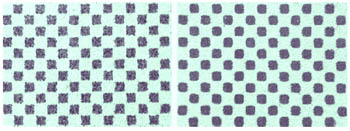
Figure 2: Conventional and CTP printing plates
One can see correctly shaped printing elements on the CTP plates whereas
the edge of the printing elements of the conventional plates is unbalanced.
The press with conventional and CTP plates has been led under the
same controlled conditions. The print-run has been defined according
to extended standard conditions (200.000 prints/conventional plates,
350.000 prints/CTP plates). The prints on app. 10.000 have been measured
on 40% coverage and the values of the mechanical and optical differences
of the screen elements are shown in the Figure 3 and 4.
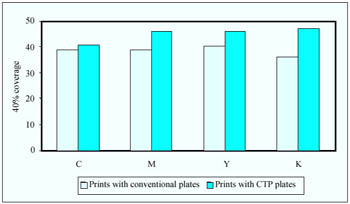
Figure 3: Mechanical differences of the screen
elements on the prints
One can see that there is a mechanical deformation between 5% and
8% on the conventional prints and about 6% on the CTP prints (Figure
3). There is also an optical deformation of 12% on the conventional
prints and about 10% and 14% on the CTP prints (Figure 4).
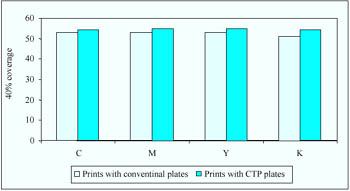
Figure 4: Optical differences of the screen elements
on the prints
On the basis of the measured values the dot gain which is shown in
the Figure 5 has been defined. The dot gain on the conventional prints
is between 8% and 14% and on the CTP prints it is between 15% and
18%.
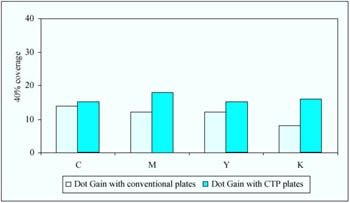
Figure 5: Dot Gain at 40% coverage
The changes on the printing elements of the printing plates, which
derive from large print-runs, have been followed. The change in the
coverage value on the prints after a certain number of prints depending
on press conditions and material used has been noticed.
As a consequence there are changes on the edges of the printing elements
which result in decrease of the ink transfer from printing plate to
the paper. This demands a change of either the whole set of
printing plates or one of the separations during the reproduction.
The coverage of 40% on the printing plates has been measured before
the press. The coverage value on 40% has been measured after the
print-run of 200.000 prints for the conventional plates and 350.000
prints for CTP plates. The results are shown in the Figure 6.
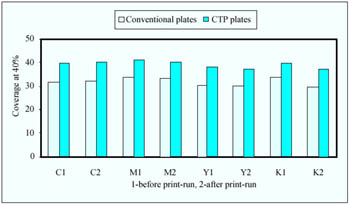
Figure 6: Coverage at 40% measured on printing
plates
One can see that there is the decrease of the coverage of the printing
elements in both cases with the same press conditions and extended
standard conditions. The decrease of the surface coverage is about
4% with the conventional plates and about 1% with the CTP plates.
The decrease of the coverage is the result of the changes of the edges
of the printing elements which have lost their shape and
oleophilic characteristics. Due to that there is a lesser transfer
of ink from the printing plate to the paper which results in the smaller
coverage. Deformations become bigger with the increase of the
print-run which also has the effect on the reproduction curves.
After the extended print-runs of the conventional and CTP printing
plates the values of the mechanical and optical differences of the
screen elements on the prints (Figures 7 and 8) have been measured.
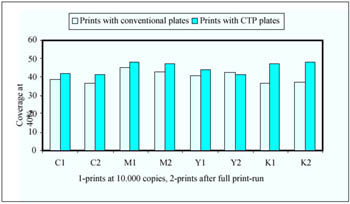
Figure 7: Mechanical differences on the prints
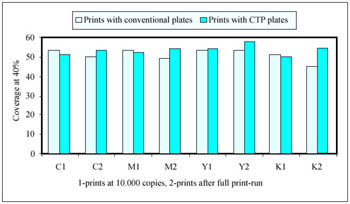
Figure 8: Optical differences on the prints
From the Figure 7 one can see that there are mechanical changes on
the screen elements of the conventional prints after the print-run
of 200.000 prints. These changes are relatively balanced. There
is a decrease of about 2% with cyan and magenta and increase of 2%
with yellow and black. The mechanical changes on the CTP prints are
significantly smaller and are about 1%. Large print-runs
caused optical decrease of 10% of the coverage of the conventional
prints and increase of 7% of the coverage on the CTP prints
(Figure 8).
The changes in the density on the conventional and CTP prints have
also been followed. In the Figures 9 and 10 the relation between the
density on the 40% and the size of the print-run can be seen.
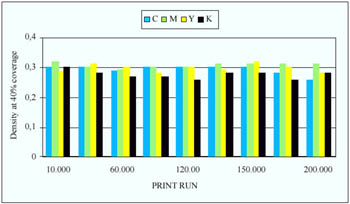
Figure 9: The density of the conventional prints
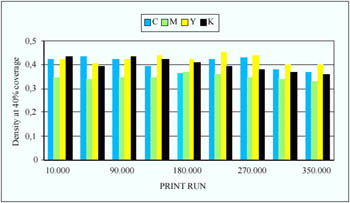
Figure 10: The density of the CTP prints
From the figures one can see that the density of the 40% of the coverage
in both cases is balanced and moderately decreased. It means that
both conventional and CTP plates would endure even larger print- run
than extended conditions, but the quality of the prints slowly decreases
due to visible damages on the edges of the printing elements. The
microscopic images of the conventional prints at 10.000 and after
200.000 print-runs, and of the CTP prints at 10.000 and after 350.000
prints can be seen in Figures 11 and 12.
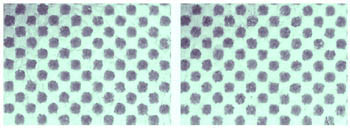
Figure 11: Images of conventional prints

Figure 12: Images of CTP prints
5. Conclusions
The mechanical and optical characteristics of prints also depend on
the platemaking system. The CTP system is a big step forward in the
platemaking process. The coverage defined on the original is
correctly transferred on the CTP printing plate. The shape of the
printing element corresponds to the computer defined element. On the
conventional printing plates there is a decrease of the coverage and
the form of the printing element deforms due to undercopying and developing
processes (Figure 2). The dot gain is slightly bigger in the CTP printmaking
system. The dot gain on the conventional prints will be smaller than
on the CTP prints under the same condition of the press. These results
show the need for the adjustment of the printing process in the systems
with the CTP platemaking, in order to achieve the satisfying tone
reproduction curves. The changes in these reproduction curves can
be
compensated by using the specified profile inherent to the system
in question.
Observing the changes of the printing elements on the printing plates
which come as a result of the large print-runs leads to the following:
the controlled conditions of the press and the same paper will
bring more consistent results with the CTP printing plates. The changes
in the density of the middle tones in both cases are insignificant.
Certain mechanical deformations and damages on the edges of the printing
elements of the conventional printing plates point to the possible
loss of the quality due to the increase of the print-run. The expectations
have been confirmed with the CTP printing plates.
There have been no significant changes on the printing elements nor
differences in density in spite of large print-runs. Such results
show greater stability of the CTP system. By introducing the CTP technology
in the printing houses it is possible to simplify the information
flow in the production, the time required for the prepress and the
whole production becomes considerably shorter. The printing elements
on the prints with the CTP printing plates are more correctly shaped
which makes more accurate reproduction. By adjusting the conditions
in the printing department with the CTP printing plates, one can achieve
the correct tone reproductions curves and the decrease of the ink
and fountain solution quantity. By eliminating of the film making
process it is possible to achieve more positive economic effect in
the context of saving graphic material and chemical substances. From
the ecological point of view this technology contributes to maintaining
the quality of the environment (Mittelhaus, Wilkesmann, 1997).
Literature references
Adams Richard M., Romano F., (1996), Computer
to Plate: Automating the Printing Industry, Graphic Arts Technical
Foundation, USA
Born E., (1983), Handbuch der Rasterphotographie,
Verlag Ambripress Basel, Basel, 13-19
Diamond, A. S., (1991), Handbook of Imaging Materials,
Marcel Dekker, Inc., NY, 61-157
Mittelhaus M., Wilkesmann C., (1997), Computer to
Plate Technologie aus ökologischer Sicht,
Deutscher Drucker 30-31, 15-17
Richter S., (1978), Lichtempfindliche Diasoschichten
auf Offsetplatten, Fachhefte Bulletintechnique 4, 178-186
Riedl R., Neumann D., Teubner J., (1989), Technologie
des Offsetdrucks, Fachbuchverlag Leipzig, Leipzig
Seydel M., (1996), Computer to Plate: Digital Workflow
and Integration into Quality Offset Printing, TAGA Proceedings, Rochester
(NY), 634-648
Van hunsel J., Van Damme M., Vermeersch J., Elsässer A., (1998), Thermostar:
A new Thermal Litho Printing Plate Technology for CTP Recording, TAGA
Proceedings, Rochester (NY), 395-409